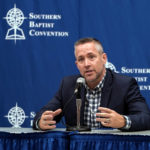Understanding Sexual Abuse: A Guide for Ministry Leaders and Survivors
By Tim Hein (InterVarsity)
There are certain places I don’t want to revisit, an auto shop and the dentist being two of them. We go to these places because we have to, but as bad as things like auto repairs and dental work can be, none compare to the experience of child sexual abuse. So, why read a book about it?
 If you’re going to read only one book about child sexual abuse, this is a good one.
If you’re going to read only one book about child sexual abuse, this is a good one.
As Debra Hirsch states in the “Foreword” to Understanding Sexual Abuse, “No Christian leader can answer the call of ministry today and not be informed about this issue.”
With the continuing scandal in the Roman Catholic Church, the recent Fort Worth Star-Telegram report of widespread abuse in Independent Fundamental Baptist churches, the slew of stories coming out of evangelical churches throughout the United States and the heartbreaking reality that many abuse victims continue suffering in silence, Hirsch’s words are absolutely correct.
Where is it safe to talk about sexual abuse?
Although we might not want to talk or read about child sexual abuse, from the beginning of the book, Tim Hein makes Understanding Sexual Abuse at least a safe place to go.
Hein is himself a survivor, as is his wife, Priscilla. They each share parts of their story, none of which introduce or reintroduce the reader to trauma, a pledge Hein makes in the introduction and keeps throughout the remainder of the book.
How do we create safe places for the abused?
Creating safe places is imperative in preventing and responding to sexual abuse. A starting point for leaders in creating safe environments is being aware of their position as leaders. Leaders must not force disclosure or dig into a survivor’s story. Full, genuine and compassionate listening is the essential posture, as described in chapter one.
How does sexual abuse affect a person?
Many around us—whether or not they’ve experienced sexual abuse—have been traumatized. Chapter two explains symptoms of trauma, important information for anyone working with people. Interestingly, we often do not associate the trauma of war with the experience of sexual abuse, but the presenting symptoms frequently are identical.
The latter half of the chapter details common experiences of surviving sexual abuse. These descriptions provide helpful inside information for those seeking to care for survivors, as well as giving survivors a comforting mirror in which to see their reflection.
Sign up for our weekly edition and get all our headlines in your inbox on Thursdays
What to do when the secret comes out?
Disclosure is a critical moment in the outworking of sexual abuse in a person’s life. Chapter four provides crucial—even if general—information to individuals hearing disclosures. Ministry leaders must be knowledgeable of the reporting guidelines for their state. In Texas, the legal requirements and reporting instructions are available online.
One of the most helpful parts of this chapter is the distinction Hein makes between hearing a child’s disclosure and hearing an adult’s.
Just what is healing supposed to look like?
In chapter four, Hein describes the slow and lurching road of working toward recovery from sexual abuse. He is honest about the pairing of prayer and faith with professional counseling and therapy. Sexual trauma weaves deep threads, and having another person to help untangle them is a Godsend.
Shouldn’t the abuser have to pay?
Anger, bitterness and resentment are very real challenges for those desiring to overcome sexual abuse. Hein gently guides his readers through questions about forgiveness and justice in chapter five. He makes startling statements: “To forgive is first to condemn” (p. 99), and “Trust is not a commandment. It must be earned” (p. 111).
Where was God then, and where is God now?
I suspect every trauma survivor wonders about God at some point, whether or not they dare ask the question. When the question is voiced, those who hear it do best to listen and not provide a systematic theology, though Hein can’t resist a short philosophic response to the existence of evil. In chapter six, he describes how ministry leaders can come alongside abuse survivors in a Christ-like posture, demonstrating confidence in Christ in the midst of tough questions of faith.
What to do with brokenness?
Chapter seven is a more wide-ranging chapter than the rest, covering several topics: the need of survivors to allow themselves to experience grief fully, to enter into sadness as catharsis and restoration; reading the Psalms as a curriculum in lament; including lament in worship services to represent accurately the world the way it is; advocating for survivors; an exposition of Christ’s crucifixion as God’s identification with our brokenness; and finally, hope.
Where do I go from here?
Hein closes Understanding Sexual Abuse with a chapter written directly to survivors in which Priscilla recalls a turning point in her journey of recovery. Tim outlines a set of simple, interesting and practical ways he and Priscilla have found to be helpful in their respective processes of healing. One point needing further elaboration is a survivor’s resilience in times of stress.
Other helpful resources Hein references are The Courage to Heal, written to women by Ellen Bass and Lauren Davis, who write from a non-Christian perspective, and Healing the Wounded Heart by Dan Allender. Allender is an expert in trauma and abuse therapy. His earlier book, now in a new edition—The Wounded Heart: Hope for Adult Victims of Childhood Sexual Abuse—dives deep into Christian self-examination and, for survivors further along in recovery, could be a good follow-up to Understanding Sexual Abuse.
Eric Black, executive director, publisher and editor
Baptist Standard














We seek to connect God’s story and God’s people around the world. To learn more about God’s story, click here.
Send comments and feedback to Eric Black, our editor. For comments to be published, please specify “letter to the editor.” Maximum length for publication is 300 words.